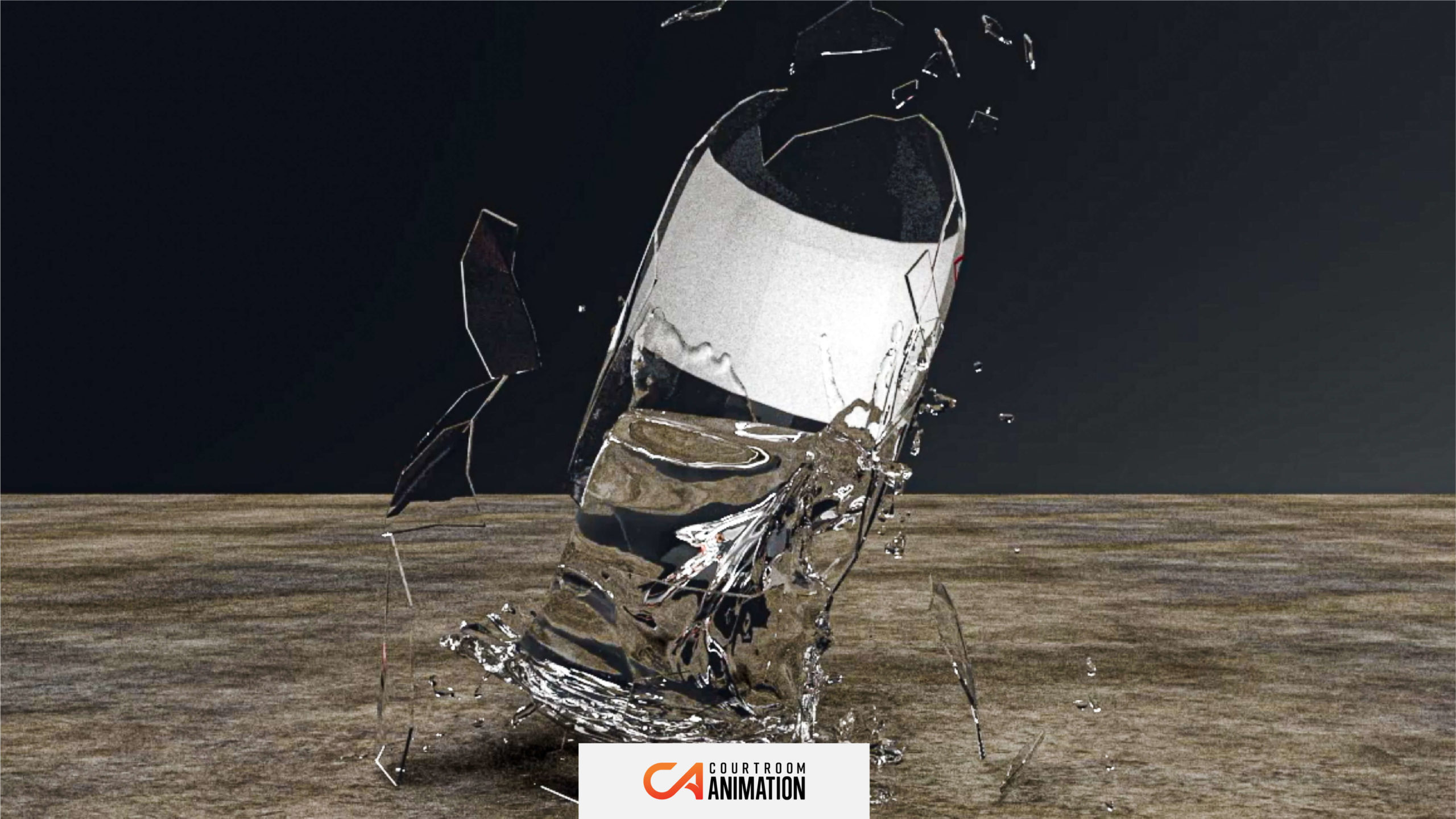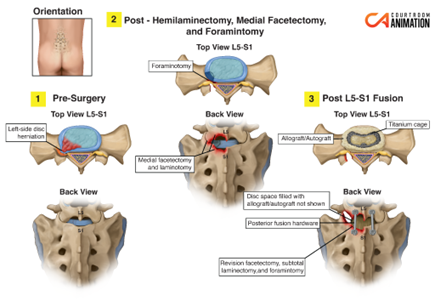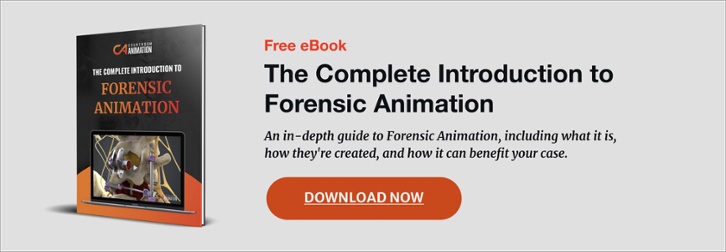
If a picture is worth a thousand words, then demonstrative evidence could be worth hundreds of thousands of dollars.
Why? Because presenting a case supported by visual evidence provides attorneys with a stronger argument. This type of visual evidence gives both plaintiff and defense counsels an upper-hand, and can lead to a more favorable settlement or verdict.
When it comes to your case, demonstrative evidence can be a game-changer. But what exactly is demonstrative evidence, and how do attorneys leverage it in litigation? In this article, we’ll expand on what demonstrative evidence is, how you can use demonstrative evidence in your court proceedings, how it impacts your case, and why you should consider experienced legal animators.
What is Demonstrative Evidence?
Demonstrative evidence covers all of the visuals or devices used in civil litigation that bolster an attorney’s, or their expert’s, positioning.
While expert testimonies or depositions are integral to a case, words alone may not resonate with the jury. In fact, studies have shown that jurors retain 87% of visual information, but only 10% of what is spoken.
Seeing a visual increases the chance that a jury will understand the facts. It’s the difference between your accident reconstruction expert listing off a jargon-filled medical report, or using a visual to walk the jury through the surgery as if it was happening right then.

Demonstrative Evidence Still: Visualizing a Motor Vehicle Collision
Since demonstrative evidence focuses on supporting only factual information, it generally has a high admissibility rate. Judges determine a visual evidence’s admissibility based on how relevant it is to the case and if it creates other conclusions not present in the evidence itself.
So, what does demonstrative evidence look like in litigation?
Demonstrative Evidence Examples
Typically, one piece of evidence doesn’t win a trial or settlement discussion. To bring a solid argument home to the jury, you must paint your narrative with comprehensive types of proof that surround your case’s strategy.

2D Demonstrative Medical Still Example from Courtroom Animation
Demonstrative evidence is simply visual support; therefore, it’s limited only to tying visual representation to facts. There are several types of demonstrative courtroom graphics that can support your case, including:
- 3D Models
- 3D or 2D Diagrams
- Photographs
- Video Analysis
- Accident Reconstruction Videos
- Maps
- Timelines
- Legal Graphics
- Medical Animations
While visual representations enhance memory, they also help simplify complicated messages and bring imagery into spaces where jargon creates confusion. For example, in a case where an attorney leveraged medical animations, the plaintiff claimed that denying a specific procedure had caused prolonged pain.
While the plaintiff could describe the pain, and medical professionals could orally explain the issue, a medical illustration effectively conveyed what was experienced. The jurors most likely would not have retained information like “left-sided L5-S1 hemilaminectomy” without the surgery animation as a reference.
The use of visual representations along with verbal explanations can increase understanding by up to 65%. When the jury completely understands the argument, that gives your case leverage in mediation or trial. So much so that in one instance, an initial settlement offer went from $450K to $1 Million after the defense was provided with an accident reconstruction animation. That represented an over 20x return on the investment of the animation!
How Demonstrative Evidence Impacts Your Case
Strategically utilizing demonstrative evidence isn’t limited to just trials. Supporting your facts early on in litigation may encourage a favorable settlement.
Forensic animation is one type of demonstrative evidence that can have a powerful impact on supporting a witness’s testimony or deposition. Forensic animation, a type of demonstrative evidence, is a recreation to corroborate the testimony while highlighting the narrative that might be missed in an oral account.
Download our free forensic animation pricing guide to learn the average costs for various types of visuals.
The animation allows your viewers to see what is being said. This ability becomes particularly critical when your expert(s) gives testimony or a deposition.
Presenting visual litigation aids during any phase of the legal process offers many benefits. If you offer it early on, the opposing counsel may see how well supported the facts are and settle in your favor faster.
Tip: Always ensure that you present your demonstrative evidence to your expert and opposing counsel. This allows you an opportunity to revise and sharpen its effect based on their feedback or objections.
The Advantages of Demonstrative Exhibits
Whether you support your facts with animation, illustration, or trial graphics, the visual representation can have a memorable impactful. The majority of the world are visual learners, so incorporating demonstrative evidence helps:
- Attention and Retention: As the world remains ever-connected to electronics and a constant stream of visual stimulation, your jury is more likely to be attentive to visual representations. Jurors are also likely to remember what they saw versus what was said with the support of animation.
- Simplifying Facts: In complicated cases where details can be missed during testimony, a visual exhibit can depict a collaboration of events and hidden nuances through reconstruction animation.
- Visualize Expert Testimony/Depositions: Cases that involve insurance, medical malpractice, or other complex fields will employ expert testimony or deposition that is riddled with industry-specific jargon. If the viewers can picture what the experts are saying, they’ll be able to understand your case faster.
- Establish a Clear Timeline: The use of timeline graphics helps put into perspective the details of a case as the events occurred. Timeline graphics can also highlight how these dates are essential to the facts.
Demonstrative Evidence Enhances Credibility & More
In short, demonstrative animations includes legal visuals and devices that support facts and your credibility by visually authenticating what is being presented as facts. Demonstrative evidence covers graphics, animations, drawings, models, video analysis, or recreations.
Each of these types of evidence can strengthen your case’s core argument. Demonstrative evidence can also encourage more favorable and faster settlements when used early in litigation. Your trial graphics presentation will command attention and leave an impression on the jury.
If you’re interested in learning more about demonstrative evidence, bookmark this forensic animation guide for attorneys.
Collaborate with our forensic animators for a well-planned and precisely executed visual aid to strengthen your case. Courtroom Animation has over a 99% admissibility rate on more than 2,000 cases. Download the eBook below to learn more about how we create forensic animation and more!
